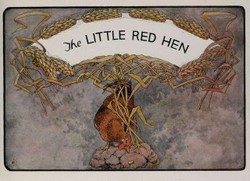Joyce Carol Oates is one of the most prolific authors of our time. She published this story in 1966. The story tells the tragic tale of a naive girl who gets kidnapped and presumably raped and murdered by the ironically titled villain, Arnold Friend. The story was included in "Best American Short Stories: in 1967" and won the O'Henry award in 1967. It was also made into a full length feature film starring a young Laura Dern. Oates is the author of over fifty novels and numerous short story collections. She is currently a professor at Princeton University. What follows is a character analysis of the story's protagonist, Connie.

A Close Look at Joyce Carol Oates' short story "Where are you Going, Where Have you been?"
by PDXJPrice
This short story, published first in Epoch in 1966 is dedicated to Bob Dylan and was inspired by the Pied Piper of Tuscon, a serial killer active in the mid 1950's.
Joyce Carol Oates' "Where Are You going, Where Have you Been"
Connie, a character analysis.
“Where Are You Going, Where Have You Been” by Joyce Carol Oates features a fifteen year old protagonist named Connie. She is quite clichéd and, upon a first read, a static character. She is made up of vanity and naiveté. These attributes cause her to be rather unlikeable and eventually, lead to her presumed demise. In the end, though, when she finally realizes the gravity of her situation, she chooses to sacrifice herself for the good of her family, thus, redeeming herself, in a way, and allowing for the argument of her as a dynamic character to be made.
Connie is quite vain, but this likely stems from insecurity. The narrator opens the story by saying that Connie is always looking in the mirror which she does to make sure her own face is okay, showing both her vanity and her insecurity: “[S]he had a quick, nervous giggling habit of craning her neck to glance into mirrors, or checking other people’s faces to make sure hers was alright.” This is the second sentence in the story. It’s obviously of great importance to the story and as a glimpse into her character.
The narrator tells us that Connie’s mother used to be quite pretty (that is, is photo books do not lie) so, perhaps, Connie is worried that someday she will be like her mom, or, worse, her plain and chunky sister. This vanity and insecurity plays into her naiveté, allowing Arnold Friend’s compliments about and to her to soften her and lower her inhibitions, keeping her in conversation with him. This turns out, of course, to be a very grave mistake.
Oates employs an objective narrator that keeps Connie at the focus. It’s told in third person limited omniscient, but, the narrator gives the reader enough clues about the danger Connie is in to let the reader in on the truth whilst allowing Connie to continue in her naiveté. This story had to be told in third person limited omniscient from the viewpoint of Connie. Connie herself can’t tell the story because she doesn’t actually know what’s going on, but telling it through someone else’s eyes decreases the tension in the story. She is not aware that there is a story to be told and, by the time she does, she’s too frantically trying to survive to do anything about it. The third person narrator sees what Connie sees and is able to convey that to the reader, even as our protagonist remains in the dark. This is what builds the tension in the story.
The tone is consistent throughout. Her naiveté runs so deep, even when Connie begins to sense danger, she still seems to have some excuse to explain it away. “’Maybe you’d better step out here,’ he said, and this last was in a different voice. It was a little flatter, as if the heat was finally getting to him.” The different, likely more sinister voice, is blamed on the heat.
Her cluelessness is consistent right up through to the climax in the story, which leaves the reader with little doubt as to what is going to happen to Connie. Her naiveté is snapped—far too late— when she finally reaches for the phone and considers calling the police (though it’s quite likely that her suspicions began to be aroused when she noticed that Ellie, Friend’s partner was “about forty”). Still, even at this critical moment, she sets the phone down and, essentially, giving—perhaps even resigning herself to—her fate. She finally achieves clarity and understanding in the final paragraph of the story when she realizes she is alone and is going to experience something quite dreadful: “[She} was taken up just the same by the vast sunlit reaches of the land behind him—so much land that Connie had never seen before and did not recognize except to know that she was going to it.” She is also her great moment of heroism and redemption where she experiences a change, showing her to be a dynamic character at the last possible moment.
 | Fox: A NovelOnly $15.65 |
 | Them (Modern Library)Only $10.63 |
 | Zombie: A Novel |
 | Butcher: A Novel |
 | Beasts (Otto Penzler Books) |
 | A Garden of Earthly Delights (20th Century Rediscoveries Series) |
Connie does seem somewhat observant about people, but not terribly astute regarding her surroundings. When Arnold Friend comes to her home, she doesn’t initially recognize the car, even though our narrator is careful to let us know that it’s a car she has seen before and should be familiar with. The reader knows she saw the car because the narrator tells us that the driver of that car (the car, at both appearances being referred to as a “jalopy”), earlier in the story said he was “Gonna get you baby” and wagged his finger at her”.
On top of this, it takes her quite a while to ascertain that Arnold and Ellie are not peers but are actually adults. She falls for the front he, Friend, puts on, trying to act younger than he is by listening to the music he thinks the kids listen to dressing the way Friend perceives kids as dressing. Something seems off to Connie, but she can’t put her finger on it until it’s far, far too late.
At no point in the conversation does she attempt to lock the front door and, when she tries to lock the screen, Arnold dissuades her telling her a screen door “is nothing” and he could just “kick it in”. Even when she begins to grow wary and suspicious, she does not act right away. Arnold threatens her “people” so she doesn’t call the police or try to get away until the very end of the story. Eventually, she gives up and sacrifices herself for her family. This is the first real redeeming quality we see in Connie.
The dichotomous part about Connie’s naiveté, however, is her basic intelligence and the way she looks down on those whom she views as less intelligent then herself. “[H}er mother was simple and kindly enough to believe her. Her mother was so simple, Connie thought, that it was may be cruel to fool her so much.” [594]. Clearly this shows that Connie views herself as intelligent—at least much more so than her mother—and this makes the reader all the more intrigued by Connie’s basic stupidity, at least in the realm of practical, street knowledge.
Overall and throughout the story, Connie is shown to be vain and naïve. Much of her vanity stems from her insecurity. These basic traits do not change throughout the story until the very end, when Connie ultimately redeems herself. In the end, it could be argued that she is heroic, opting to, presumably, sacrifice herself to save her family (though it’s certainly possible she herself was unaware of the gravity of her actions nor her situation). These negative attributes lead to her ultimate demise, and redemption.
I also write
You can also find my writing in several issues of EFiction magazine and the Bellwether Review. This was my seventh Wizzley article. Thanks for reading. I hope you enjoyed it!
You might also like
10 Lessons from The Little Red HenLittle Red Hen is a simple story with great potential for school lessons. We ...
Pumpkin Story Books, Posters and Cartoon Pumpkins for HalloweenThis is your chance of re-discovering the pumpkins with your kids in story bo...





 The Night My Mother Met Bruce Lee, a Brief Opinionon 07/09/2012
The Night My Mother Met Bruce Lee, a Brief Opinionon 07/09/2012
 A Close Look at Emily Grierson From "A Rose for Emily"on 06/12/2012
A Close Look at Emily Grierson From "A Rose for Emily"on 06/12/2012
 A close look at "Sabotage"on 03/30/2012
A close look at "Sabotage"on 03/30/2012



Comments
Sher, she's a pretty dense read and I don't usually care for dense but, like Dickens, she's really skilled and tells such a captivating story. Thanks so much for reading and commenting!
I have had a hard time getting into Oates' books, but I will give it another try after reading this review.
Thanks for reading, Kate. you really can't go wrong with Joyce Carol Oates. She is so rich and prolific in her writing.
Great review, my daughter 13 and 16 will enjoy reading this book by Carol Oates, thanks for the great summer book reviews and reading list.